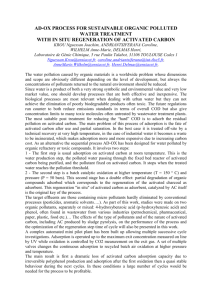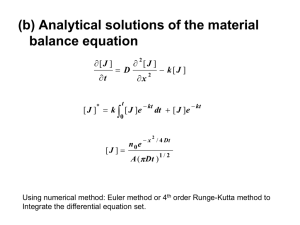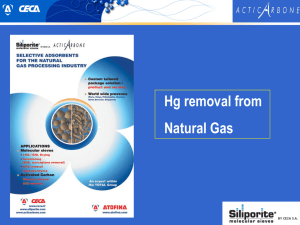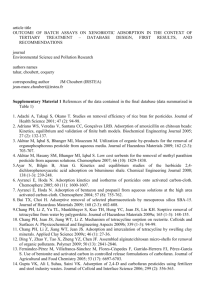Format And Type Fonts
advertisement
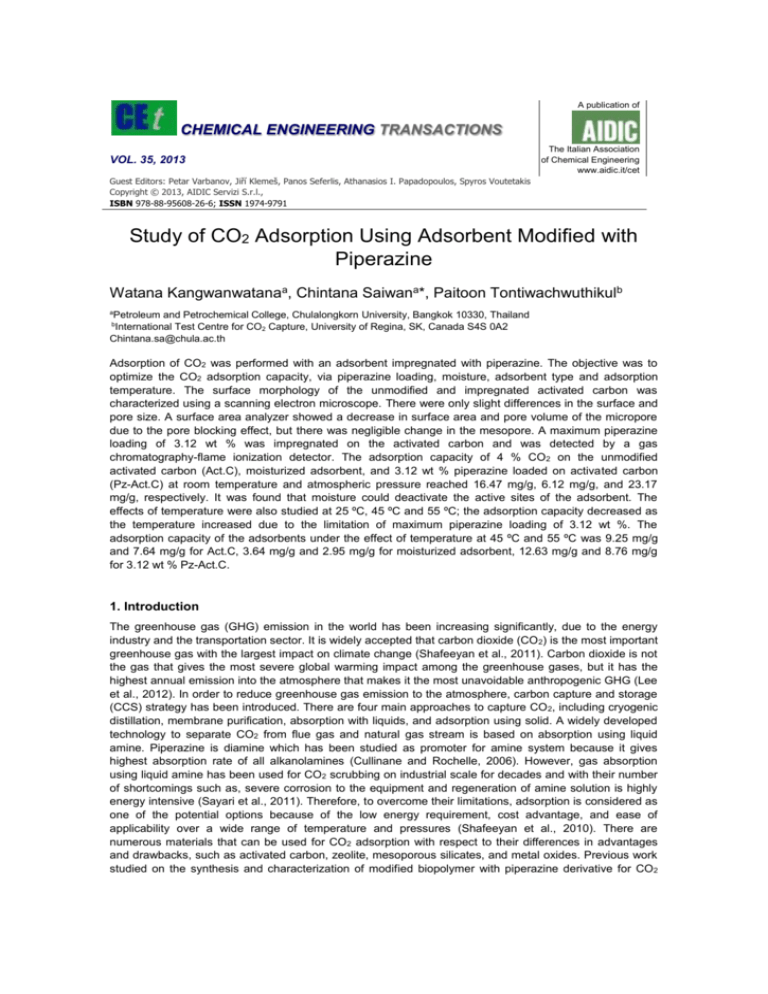
A publication of CHEMICAL ENGINEERING TRANSACTIONS VOL. 35, 2013 The Italian Association of Chemical Engineering www.aidic.it/cet Guest Editors: Petar Varbanov, Jiří Klemeš, Panos Seferlis, Athanasios I. Papadopoulos, Spyros Voutetakis Copyright © 2013, AIDIC Servizi S.r.l., ISBN 978-88-95608-26-6; ISSN 1974-9791 Study of CO2 Adsorption Using Adsorbent Modified with Piperazine Watana Kangwanwatanaa, Chintana Saiwana*, Paitoon Tontiwachwuthikulb a Petroleum and Petrochemical College, Chulalongkorn University, Bangkok 10330, Thailand International Test Centre for CO2 Capture, University of Regina, SK, Canada S4S 0A2 Chintana.sa@chula.ac.th b Adsorption of CO2 was performed with an adsorbent impregnated with piperazine. The objective was to optimize the CO2 adsorption capacity, via piperazine loading, moisture, adsorbent type and adsorption temperature. The surface morphology of the unmodified and impregnated activated carbon was characterized using a scanning electron microscope. There were only slight differences in the surface and pore size. A surface area analyzer showed a decrease in surface area and pore volume of the micropore due to the pore blocking effect, but there was negligible change in the mesopore. A maximum piperazine loading of 3.12 wt % was impregnated on the activated carbon and was detected by a gas chromatography-flame ionization detector. The adsorption capacity of 4 % CO2 on the unmodified activated carbon (Act.C), moisturized adsorbent, and 3.12 wt % piperazine loaded on activated carbon (Pz-Act.C) at room temperature and atmospheric pressure reached 16.47 mg/g, 6.12 mg/g, and 23.17 mg/g, respectively. It was found that moisture could deactivate the active sites of the adsorbent. The effects of temperature were also studied at 25 ºC, 45 ºC and 55 ºC; the adsorption capacity decreased as the temperature increased due to the limitation of maximum piperazine loading of 3.12 wt %. The adsorption capacity of the adsorbents under the effect of temperature at 45 ºC and 55 ºC was 9.25 mg/g and 7.64 mg/g for Act.C, 3.64 mg/g and 2.95 mg/g for moisturized adsorbent, 12.63 mg/g and 8.76 mg/g for 3.12 wt % Pz-Act.C. 1. Introduction The greenhouse gas (GHG) emission in the world has been increasing significantly, due to the energy industry and the transportation sector. It is widely accepted that carbon dioxide (CO 2) is the most important greenhouse gas with the largest impact on climate change (Shafeeyan et al., 2011). Carbon dioxide is not the gas that gives the most severe global warming impact among the greenhouse gases, but it has the highest annual emission into the atmosphere that makes it the most unavoidable anthropogenic GHG (Lee et al., 2012). In order to reduce greenhouse gas emission to the atmosphere, carbon capture and storage (CCS) strategy has been introduced. There are four main approaches to capture CO 2, including cryogenic distillation, membrane purification, absorption with liquids, and adsorption using solid. A widely developed technology to separate CO2 from flue gas and natural gas stream is based on absorption using liquid amine. Piperazine is diamine which has been studied as promoter for amine system because it gives highest absorption rate of all alkanolamines (Cullinane and Rochelle, 2006). However, gas absorption using liquid amine has been used for CO2 scrubbing on industrial scale for decades and with their number of shortcomings such as, severe corrosion to the equipment and regeneration of amine solution is highly energy intensive (Sayari et al., 2011). Therefore, to overcome their limitations, adsorption is considered as one of the potential options because of the low energy requirement, cost advantage, and ease of applicability over a wide range of temperature and pressures (Shafeeyan et al., 2010). There are numerous materials that can be used for CO2 adsorption with respect to their differences in advantages and drawbacks, such as activated carbon, zeolite, mesoporous silicates, and metal oxides. Previous work studied on the synthesis and characterization of modified biopolymer with piperazine derivative for CO2 adsorption (Saiwan et al., 2012). In this study, the adsorbent will be modified with piperazine to improve the adsorption rate and adsorption capacity. 2. Materials and methods 2.1. Materials 2.1.1 Activated palm shell based carbon, amine and based chemical A commercial activated carbon; granular activated palm shell based carbon was supplied by Carbokarn Co., Ltd., (Thailand). Piperazine anhydrous (PZ, AR grade, ≥99 %) with a molecular weight of 86.14 g/mol was obtained from Merck. Ethanol (AR grade, 99 %) with a molecular weight of 46.07 g/mol was obtained from RCI Labscan, Thailand. 2.2. Experimental setup Figure 1: Schematic flow diagram for CO2 adsorption. In Figure 1, the outlet flow rate released from the gas cylinders is controlled by mass flow controllers before mixing premixed 15 % CO2/N2 with pure N2 in the mixing chamber to obtain 4 % CO2. The mixed gas is then controlled to a fixed pressure for ventilation and enabling a small quantity of 4 % CO2 gas to pass through the rotameter which the flow rate will be adjusted to 5 mL/min determined by a bubble flow meter. Before testing CO2 adsorption through the adsorption column, the 4 % CO2 gas is analyzed by a gas chromatography-thermal conductivity detector (GC-TCD) in comparison with the calibration curve of CO2 gas. The adsorption column is a tubular glass flow adsorber with an inner cell diameter of 4 mm, outer cell diameter of 6 mm, and 39 cm long. It is vertically oriented for the even distribution of adsorbent. The column, covered with a 40 cm long insulator wound with a heating tape, is used to maintain a stabilized temperature throughout the whole experiment. In the top 18.5 cm of the column, the adsorbent was packed and emplaced with glass wool at the top and the bottom to support the activated carbon, so the feed was running against gravity. The thermocouple was inserted at the bottom of the column to determine the temperature of internal column. 2.3. Activated carbon preparation Granular size activated carbon was crushed and sieved to obtain a 20-40 mesh size followed by heating in a 60 ºC oven for 6 h and kept in a desiccator at room temperature to avoid the moisture effect. 2.4. Impregnation process The dry activated carbon was impregnated with 30 wt %, 40 wt % and 50 wt % piperazine. For the 30 wt % sample, 0.15 g of piperazine crystals were dissolved in 5 mL of ethanol until completely dissolved then mixed with 0.5 g of activated carbon. The mixture was mixed in a 50 mL beaker at 500 rpm using a magnetic bar on a stirring hot plate (C-MAG HS10 IKA®,USA) for 2 h. The top was sealed with parafilm. Next it was filtered using a suction pump. The impregnated piperazine was then dried in an oven at 60 ºC for 1 ½ h to completely remove the ethanol. The procedure was repeated for the preparation of 40 wt % and 50 wt % with 0.2 g and 0.25 g of piperazine, respectively. 2.5. Moisturized activated carbon and impregnated activated carbon The dry activated carbon and impregnated activated carbon were kept in the desiccators were equilibrated in a moisturized and close system for 20 h at room temperature. 2.6. Activated carbon beds and CO2 adsorption measurement Activated carbon beds used were unmodified activated carbon bed, impregnated activated carbon and moisturized activated carbon. The conditions for each experiment performed were 5 mL/min of 4 % CO 2 feed gas flow at room temperature (25 ºC), 45 ºC and 55 ºC at an atmospheric pressure using 0.5 g of each prepared adsorbent in the adsorption column. Rt®-Q-BOND column with 0.53 mm id x 20 µm film thickness x 30 m length was used to operate at an isothermal temperature of 40 ºC. The GC-TCD injection port was heated to 100 ºC with a spilt flow of 8 mL/min and helium as a carrier gas. In typical CO2 adsorption, 0.5 g of adsorbent is filled into a tubular flow glass adsorber column that was heating tape wounded around and covered with an insulator. After line cleaning-up, 0.5 g of adsorbent in the column was pre-dried at 60 ºC for 1 h while purging with N2 gas at 113 mL/min. Then, 4 % premixed CO2 of dry gas at 5 mL/min was allowed to flow into the packed bed adsorber in order to carry out the experiment at room temperature and atmospheric pressure until the CO2 concentrations of the feed gas at the outlet of adsorber reached equilibrium. The concentrations of CO 2 in the downstream in terms of chromatogram were continuously monitored using the WiniLab III V4.6 computer program. The dynamic adsorption capacity of the adsorbent (Qads) was calculated with Eq (1), Qads= FC0 tq (1) W where F (mol/min) is the total molar flow of feed gas, C 0 is the CO2 concentration of the inlet stream, W is the mass of the solid adsorbent loaded in the column, and t q (min) is the stoichiometric time which was determined from the breakthrough curve according to Eq (2) via MATLAB software version 7.10.0.499 (Guerreero et al., 2010), ∞ tq = ∫0 (1 − CA C0 ) dt (2) where C0 and CA are the CO2 concentrations of inflow and outflow gas stream of the column, respectively. 2.7. Characterization equipment 2.7.1. Surface area analysis A surface area analyzer (Autosorb-1MP, Quantachrome, USA) was used to analyze the surface area of the adsorbent. The specific surface area, SBET, was determined from the linear part of the BrunauerEmmett-Teller (BET) equation and the calculation of pore size distribution was performed using the BarretJoyner-Halenda (BJH) equation using the full isotherms method. These parameters were calculated to identify the effects before and after piperazine loading via the impregnation method. 2.7.2. Surface morphology A scanning electron microscope (SEM; S-4800, Hitachi, Japan) was used to analyze the surface morphology of the adsorbent. The sample was placed on a carbon tape which was coated with platinum under vacuum. The SEM images were captured at a magnification of 2,000 and 100,000 to distinguish the pore site distribution of the activated carbon before and after piperazine loading via the impregnation method. 2.7.3. Thermal stability study The thermal stability of the pure activated carbon and impregnated activated carbon was determined in a nitrogen atmosphere by thermogravimetic differential analysis (TG-DTA, Perkin Elmer Thailand Co., Ltd). 4–20 mg of sample was weighed on the heating pan in the chamber, then was heated at a ramping rate of 5 ºC/min at room temperature with 90 mL/min of N2 flow to 900 ºC. 2.7.4. Degree of piperazine loading (wt %) on impregnated activated carbon The impregnated activated carbon was crushed into fine particles, which was then weighed and dissolved with 5 mL of ethanol. The solution was heated to 60 ºC and stirred at 250 rpm for an hour to complete the dissolution of piperazine from the activated carbon. After 1 h, the solution was cooled to room temperature then the volume was made up to 10 mL with ethanol. The fine particles of activated carbon were filtered using filter paper No. 1, then 0.04 µL of the filtrate was injected using a 0.5 µL syringe (SGC syringe) into the gas chromatography-flame ionization detector (GC-FID) via a heated injection port at 200 ºC with the split flow of 10 mL/min using helium as a carrier gas. The DB® -5 column with 0.53 mm id x 1.0 µm film thickness x 30 m length was used to operate at an initial temperature of 50 ºC, at a ramp rate of 10 ºC/min to an isothermal temperature of 120 ºC. 2.8. Characterization result Figures 2 and 3 demonstrate the surface morphology of the non-impregnated activated carbon and 40 wt % piperazine-activated carbon (20–40 mesh size) at a magnification of 100,000 times. By comparison, there is only a slight difference in the surface and pore size. The scanning electron microscope was able to observed only the macropore (> 50 nm) and the mesopore (2–50 nm) whereas higher magnifications were needed for the micropore (<2 nm). To understand the surface morphology more precisely, surface area analysis was applied in order to distinguish the changes of the non-impregnated and impregnated activated carbon pore volume and pore size distribution. There is a decrease in the surface area and pore volume of the micropore with scarcely any change in the mesopore (Table1). The decrease in the surface area could indicate that there was some amount of piperazine blocking in the micropore which resulted in a decrease in pore volume. The result supported the earlier SEM morphology that there was hardly change in the surface morphology for the macro and mesopore. However, from the result it can be assumed that 40 wt% piperazine did not entirely loaded into the pore site of the activated carbon because there was only a slight decrease in the pore volume of the micropore and not even in the mesopore. Figure 2: Non-impregnated activated carbon 20-40 mesh size magnified 100,000 times. Figure 3: 40 wt % piperazine-activated carbon 20-40 mesh size magnified 100,000 times. Table 1: Surface area analysis of non-impregnated activated carbon and impregnated activated carbon Adsorbing bed Total surface area (m2/g) 801.9 Nonimpregnated activated carbon 40 wt % 570.9 piperazineactivated carbon Mesopore surface area (m2/g) 745.2 Micropore surface area (m2/g) 764.0 Total pore volume (cc/g)e-01 Mesopore Micropore volume volume (cc/g) e-01 (cc/g) e-01 4.43 2.57 3.79 Average pore diameter (Å) 22.10 734.5 535.3 3.25 2.60 2.65 22.10 A calibration curve was done to determine the concentration of an unknown sample in the activated carbon by comparing with piperazine standards of known concentration. The result showed a maximum of 3.12 wt % of piperazine loaded on the activated carbon. The thermal stability of the piperazine, activated carbon, Mass loss (wt%) and 3.12 wt % piperazine-activated carbon were illustrated in Figure 4. Piperazine decomposes at 78.99 ºC, impregnated 3.12 wt % piperazine-activated carbon decomposes at a higher temperature of 82.84 ºC, and pure activated carbon decomposes at higher temperature than 900 ºC. 100 90 80 70 60 50 40 30 20 10 0 Piperazine 3.12 wt % piperazine-activated carbon Activated carbon 0 100 200 300 400 500 600 Temperature (oC) 700 800 900 1000 Figure 4: Thermal stability of piperazine, 3.12 wt % piperazine-activated carbon and pure activated carbon. 3. Results and Discussion 3.2. Breakthrough curve results Figure 5 illustrates the breakthrough curves of pure activated carbon and impregnated 3.12 wt % piperazine activated carbon at different temperatures at an atmospheric pressure. These curves were obtained using the WiniLab III V4.6 program in the computer connecting to the GC-TCD displaying the amount of CO2 % leaving the adsorber. The monitor displayed 0% in the beginning of the experiment as the CO2 molecules were adsorbed by the surface and the pore sites until the saturation stage showing the S-shape and reached C/C0 =1 at the equilibrium stage. From the result obtained, the increase of the adsorption temperature causes an early reach of the saturation stage. Carbon dioxide molecules are attachto the high surface area of the activated carbon by weak van der Waals force, which is a low heat of adsorption. Therefore, at an elevated temperature the attractive force between the surface of the activated carbon and the carbon dioxide molecules is reduced. The adsorption capacity (mmol/g) of the pure activated carbon at 25 ºC, 45 ºC and 55 ºC is 0.3742, 0.2101 and 0.1737. The effect of the adsorption temperature on the 3.12 wt % piperazine-activated carbon indicates that the piperazine in the activated carbon in fact contributes adsorption which enhances the physisorption of the unmodified activated carbon at different temperatures. The carbon dioxide adsorption capacity drops gradually when the temperature increases. It is assumed that physisorption still dominates chemisorption at the elevated temperature due to the limitation of maximum piperazine loading of 3.12 wt %. The adsorption capacity (mmol/g) of 3.12 wt % piperazine-activated carbon at 25 ºC, 45 ºC and 55 ºC is 0.5266, 0.2870 and 0.1990, respectively. However, the moisturized activated carbon results in a rapid saturation stage with a dramatic decrease in the carbon dioxide adsorption capacity. The adsorption capacity (mmol/g) of the moisturized activated carbon at 25 ºC, 45 ºC and 55 ºC is 0.1390, 0.0826 and 0.0670, respectively. This indicates that the moisture could have deactivated the active sites of the activated carbon. 1 0.9 0.8 0.7 0.6 0.5 0.4 0.3 0.2 0.1 0 C/C0 Act.C at 25C Act.C at 45C Act.C at 55C Pz-Act.C at 25C Pz-Act.C at 45C Pz-Act.C at 55C Moisturized Act.C at 25C Moisturized Act.C at 45C Moisturized Act.C at 55C 0 5 10 15 20 25 30 35 40 Time (mins) 45 50 55 60 65 70 75 Figure 5: Breakthrough curves of activated carbon (Act.C), piperazine-activated carbon (Pz-Act.C), and moisturized activated carbon at 25 ºC, 45 ºC and 55 ºC at an atmospheric pressure. 4. Conclusion Activated carbon beds adsorption capacity enhanced significantly after impregnation with piperazine. Although the excellence of piperazine did not reveal entirely due to the limitation of piperazine loading of 3.12 wt % as the physisorption still dominate the chemisorption. The highest CO2 adsorption capacity improvement reaches as high as 40.73 % for Pz-Act.C in comparison with pure Act.C at room temperature. The moisturizing effect did not facilitate the adsorption but worsened the adsorption. Acknowledgement The authors would like to thank The Petroleum and Petrochemical College, Chulaongkorn University for offering the necessary equipment for this research, The 90th anniversary of Chulalongkorn University Fund (Ratchadaphiseksomphot Endowment Fund), and Carbokarn Co., Ltd., (Thailand) for the activated carbon. References Shafeeyan M.S., Duad W.M.A.W., Houshmand A., 2011, Ammonia modification of activated carbon to enhance carbon dioxide adsorption: Effect of pre-oxidation. Applied Surface Science, 257, 3936-3942 Lee Z.H., Lee K.T., Bhatia S., Mohamed A.R., 2012, Post-combustion carbon dioxide capture: Evolution towards utilization of nanomaterials. Renewable and Sustainable Energy Reviews, 16, 2599-2609 Rochelle G.T., Cullinane J.T., 2006, Kinetics of carbon dioxide absorption into aqueous potassium carbonate and piperazine. Industrial Engineering Chemical Resource, 45, 2531-2545 Sayari A., Belmabkhout Y., Serna-Guerrero R., 2011 Flue gas treatment via CO2 adsorption. Chemical Engineering Journal, 171, 760-774 Shafeeyan M.S., Daud W.M.A.W., Houshmand A., Shamiri A., 2010, A review on surface modification of activated carbon for carbon dioxide adsorption. Journal of Analytical and Applied Pyrolysis, 89, 143151 Saiwan C., Srisuwanvichein S., Yoddee P., Idem R., Supap T., Tontiwachwuthikul P., Wongpanit P., 2012, Studies of modification of biopolymer with piperazine derivative for carbon dioxide adsorption, Chemical Engineering Transactions, 29, 211-216 Guerrero R.S., Belmabkhout Y., Sayari A., 2010, Further investigations of CO2 capture using triaminegrafted pore-expanded mesoporous silica. Chemical Engineering Science, 158, 513-519.
